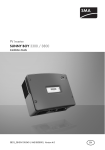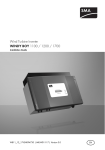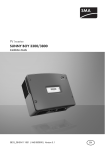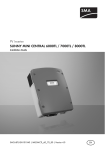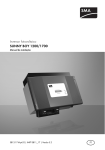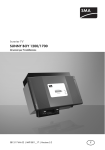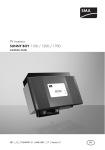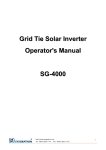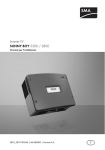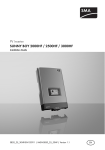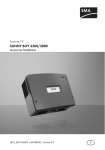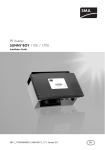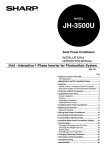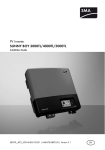Download SUNNY BOY 1200 / 1700 - Installation Guide
Transcript
PV Inverter
SUNNY BOY 1200/1700
Installation Guide
SB12_17-IEN104650 | IMEN-SB11_17 | Version 5.0
EN
SMA Solar Technology AG
Table of Contents
Table of Contents
1
1.1
1.2
1.3
1.4
Notes on this Manual. . . . . . . . . . . . . . . . . . . . . . . . . . . . . .
Scope of Validity. . . . . . . . . . . . . . . . . . . . . . . . . . . . . . . . . . . . .
Target Group . . . . . . . . . . . . . . . . . . . . . . . . . . . . . . . . . . . . . . .
Additional Information . . . . . . . . . . . . . . . . . . . . . . . . . . . . . . . .
Symbols Used . . . . . . . . . . . . . . . . . . . . . . . . . . . . . . . . . . . . . . .
2
2.1
2.2
2.3
Safety . . . . . . . . . . . . . . . . . . . . . . . . . . . . . . . . . . . . . . . . . . 9
Appropriate Usage . . . . . . . . . . . . . . . . . . . . . . . . . . . . . . . . . . . 9
Safety Precautions. . . . . . . . . . . . . . . . . . . . . . . . . . . . . . . . . . . 11
Explanation of Symbols . . . . . . . . . . . . . . . . . . . . . . . . . . . . . . 12
2.3.1
Symbols on the Inverter. . . . . . . . . . . . . . . . . . . . . . . . . . . . . . . . . . . . . . . . . 12
2.3.2
Symbols on the Type Label . . . . . . . . . . . . . . . . . . . . . . . . . . . . . . . . . . . . . . 13
3
3.1
3.2
Unpacking. . . . . . . . . . . . . . . . . . . . . . . . . . . . . . . . . . . . . . 14
Scope of Delivery . . . . . . . . . . . . . . . . . . . . . . . . . . . . . . . . . . . 14
Identifying the Inverter . . . . . . . . . . . . . . . . . . . . . . . . . . . . . . . 14
4
4.1
4.2
4.3
Mounting the Device . . . . . . . . . . . . . . . . . . . . . . . . . . . . . 15
Safety . . . . . . . . . . . . . . . . . . . . . . . . . . . . . . . . . . . . . . . . . . . . 15
Selecting the Mounting Location. . . . . . . . . . . . . . . . . . . . . . . . 15
Mounting the Inverter with Wall Mounting Bracket . . . . . . . . . 17
5
5.1
Electrical Connection . . . . . . . . . . . . . . . . . . . . . . . . . . . . . 19
Overview of the Connection Area . . . . . . . . . . . . . . . . . . . . . . 19
5.1.1
Exterior View . . . . . . . . . . . . . . . . . . . . . . . . . . . . . . . . . . . . . . . . . . . . . . . . . 19
5.1.2
Interior View . . . . . . . . . . . . . . . . . . . . . . . . . . . . . . . . . . . . . . . . . . . . . . . . . 20
5.2
Connection to the Public Grid (AC) . . . . . . . . . . . . . . . . . . . . . 21
5.2.1
5.2.2
Conditions for the AC Connection . . . . . . . . . . . . . . . . . . . . . . . . . . . . . . . . 21
Connecting the Inverter to the Public Grid (AC) . . . . . . . . . . . . . . . . . . . . . . 23
5.2.3
Connecting additional grounding . . . . . . . . . . . . . . . . . . . . . . . . . . . . . . . . . 26
Installation Guide
SB12_17-IEN104650
7
7
7
7
8
3
Table of Contents
SMA Solar Technology AG
5.3
5.4
Setting the Display Language . . . . . . . . . . . . . . . . . . . . . . . . . . 27
PV generator connection (DC) . . . . . . . . . . . . . . . . . . . . . . . . . 28
5.4.1
Conditions for the DC Connection . . . . . . . . . . . . . . . . . . . . . . . . . . . . . . . . 28
5.4.2
Assembling the DC Plug Connector . . . . . . . . . . . . . . . . . . . . . . . . . . . . . . . 29
5.4.3
Opening the DC Plug Connector . . . . . . . . . . . . . . . . . . . . . . . . . . . . . . . . . 31
5.4.4
Connecting the PV Generator (DC) . . . . . . . . . . . . . . . . . . . . . . . . . . . . . . . 32
5.5
5.6
Communication. . . . . . . . . . . . . . . . . . . . . . . . . . . . . . . . . . . . . 35
Setting the Grid and Country Parameters . . . . . . . . . . . . . . . . . 35
5.6.1
Setting the Installation Country . . . . . . . . . . . . . . . . . . . . . . . . . . . . . . . . . . . 35
5.6.2
Setting Stand-alone Grid Operation . . . . . . . . . . . . . . . . . . . . . . . . . . . . . . . 36
6
6.1
6.2
6.3
Commissioning . . . . . . . . . . . . . . . . . . . . . . . . . . . . . . . . . . 37
Commissioning the Inverter . . . . . . . . . . . . . . . . . . . . . . . . . . . . 37
Display Messages during Initialization . . . . . . . . . . . . . . . . . . . 38
Self-Test in accordance with DK 5940, Ed. 2.2
(applies to Italy only) . . . . . . . . . . . . . . . . . . . . . . . . . . . . . . . . 39
6.3.1
Starting the Self-Test by Tapping . . . . . . . . . . . . . . . . . . . . . . . . . . . . . . . . . . 39
6.3.2
Completion of the Self-Test . . . . . . . . . . . . . . . . . . . . . . . . . . . . . . . . . . . . . . 39
7
7.1
7.2
7.3
Opening and Closing. . . . . . . . . . . . . . . . . . . . . . . . . . . . . 44
Safety . . . . . . . . . . . . . . . . . . . . . . . . . . . . . . . . . . . . . . . . . . . . 44
Opening the Inverter. . . . . . . . . . . . . . . . . . . . . . . . . . . . . . . . . 44
Closing the Inverter . . . . . . . . . . . . . . . . . . . . . . . . . . . . . . . . . . 47
8
8.1
Maintenance and Cleaning . . . . . . . . . . . . . . . . . . . . . . . . 49
Checking the Electronic Solar Switch for Wear . . . . . . . . . . . . 49
9
Failure Search. . . . . . . . . . . . . . . . . . . . . . . . . . . . . . . . . . . 51
9.1
9.2
LED Codes . . . . . . . . . . . . . . . . . . . . . . . . . . . . . . . . . . . . . . . . 51
Error Messages. . . . . . . . . . . . . . . . . . . . . . . . . . . . . . . . . . . . . 52
4
SB12_17-IEN104650
Installation Guide
SMA Solar Technology AG
Table of Contents
9.3
Red LED is Glowing Continuously. . . . . . . . . . . . . . . . . . . . . . . 55
9.3.1
Checking the PV Generator for a Ground Fault . . . . . . . . . . . . . . . . . . . . . . 56
9.3.2
Checking the Functioning of the Varistors . . . . . . . . . . . . . . . . . . . . . . . . . . . 58
10
10.1
10.2
10.3
10.4
Decommissioning . . . . . . . . . . . . . . . . . . . . . . . . . . . . . . . . 60
Dismantling the Inverter. . . . . . . . . . . . . . . . . . . . . . . . . . . . . . . 60
Packing the Inverter. . . . . . . . . . . . . . . . . . . . . . . . . . . . . . . . . . 61
Storing the Inverter . . . . . . . . . . . . . . . . . . . . . . . . . . . . . . . . . . 61
Disposing of the Inverter . . . . . . . . . . . . . . . . . . . . . . . . . . . . . . 61
11
11.1
11.2
Technical Data . . . . . . . . . . . . . . . . . . . . . . . . . . . . . . . . . . 62
Sunny Boy 1200 . . . . . . . . . . . . . . . . . . . . . . . . . . . . . . . . . . . 62
Sunny Boy 1700 . . . . . . . . . . . . . . . . . . . . . . . . . . . . . . . . . . . 65
12
Accessories . . . . . . . . . . . . . . . . . . . . . . . . . . . . . . . . . . . . . 68
13
Contact . . . . . . . . . . . . . . . . . . . . . . . . . . . . . . . . . . . . . . . . 69
Installation Guide
SB12_17-IEN104650
5
Table of Contents
6
SB12_17-IEN104650
SMA Solar Technology AG
Installation Guide
SMA Solar Technology AG
Notes on this Manual
1 Notes on this Manual
1.1 Scope of Validity
This manual describes the assembly, installation, commissioning and maintenance of the following
SMA inverters:
• Sunny Boy 1200 (SB 1200)
• Sunny Boy 1700 (SB 1700)
Store this manual where it can be accessed at all times.
1.2 Target Group
This manual is for qualified personnel. The tasks described in this manual may only be performed by
qualified personnel.
1.3 Additional Information
You will find further information on special topics such as designing a line circuit breaker or the
description of the operating parameters in the download area at www.SMA.de/en.
Refer to the user manual for detailed information on operating the inverter.
Installation Guide
SB12_17-IEN104650
7
Notes on this Manual
SMA Solar Technology AG
1.4 Symbols Used
The following types of safety precautions and general information are used in this manual:
DANGER!
G
"DANGER" indicates a hazardous situation which, if not avoided, will result in death or
serious injury.
WARNING!
"WARNING" indicates a hazardous situation which, if not avoided, could result in death
or serious injury.
CAUTION!
"CAUTION" indicates a hazardous situation which, if not avoided, could result in minor or
moderate injury!
NOTICE!
"NOTICE" indicates a situation that can result in property damage, if not avoided.
Information:
Information provides tips that are valuable for the optimal installation and operation of
your product.
☑
8
This symbol indicates the result of an action.
SB12_17-IEN104650
Installation Guide
SMA Solar Technology AG
Safety
2 Safety
2.1 Appropriate Usage
The Sunny Boy is a PV inverter, which converts the DC current of the PV generator to AC current and
feeds it into the public grid.
Principle of a PV plant with this Sunny Boy
The Sunny Boy may only be operated with PV generators (modules and cabling) of protection class II.
Do not connect any sources of energy other than PV modules to the Sunny Boy.
When designing the PV system, ensure that the values comply with the permitted operating range of all
components at all times. The free design program "Sunny Design" (www.SMA.de/en/SunnyDesign)
will assist you. The manufacturer of the PV modules must have approved the modules for use with this
Sunny Boy device. You must also ensure that all measures recommended by the module manufacturer
for long-term maintenance of the module properties are taken (see also Technical Information "Module
Technology", in the download area of www.SMA.de/en).
Do not use the Sunny Boy for purposes other than those described here. Alternative uses,
modifications to the Sunny Boy or the installation of components not expressly recommended or sold
by SMA Solar Technology AG void the warranty claims and operation permission.
Installation Guide
SB12_17-IEN104650
9
Safety
SMA Solar Technology AG
Certified Countries
The Sunny Boy 1200/1700 (with according configuration) fulfill the requirements specified in the
following standards and directives (dated: 12/2010):
SB 1200
• AS4777 (2005)
• C10/C11 (05.2009)
• CER/06/190 (10.2006)*
• DK 5940 Ed.2.2 (02.2006)**
• EN 50438:2008***
• G83/1-1:2008
• IEEE929
• PPC:2006
• PPDS:2009
• RD 1663/2000 (2000)
• RD 1663/661
• VDE 0126-1-1 (02.2006)
• UTE C15-712-1****
SB 1700
• AS4777 (2005)
• C10/C11 (05.2009)
• CER/06/190 (10.2006)
• DK 5940 Ed.2.2 (02.2006)**
• EN 50438:2008***
• G83/1-1:2008
• IEEE929
• PPC:2006
• PPDS:2009
• RD 1663/2000 (2000)
• RD 1663/661
• VDE 0126-1-1 (02.2006)
• UTE C15-712-1****
* On request
** only applies to SB 1200-IT/SB 1700-IT
*** does not apply to national standard deviations of EN 50438
**** Firmware version 3.06 and higher
SMA Solar Technology AG can preset special grid parameters for other countries/installation
locations according to customer request, after evaluation by SMA Solar Technology AG. You can
make later modifications yourself by changing software parameters with respective communication
products (e.g. Sunny Data Control or Sunny Explorer) (see section 5.6 ”Setting the Grid and Country
Parameters” (page 35)). To change grid-relevant parameters, you need a personal access code - the
so-called SMA Grid Guard Code. The application form for the personal access code is located in the
download area at www.SMA.de/en, in the "Certificate" category for each inverter.
10
SB12_17-IEN104650
Installation Guide
SMA Solar Technology AG
Safety
2.2 Safety Precautions
DANGER!
Danger to life due to high voltages in the inverter!
• All work on the inverter may be carried out by qualified personnel only.
• The appliance is not to be used by children or persons with reduced physical, sensory
or mental capabilities, or lack of experience and knowledge, unless they have been
given supervision or instruction.
• Children should be supervised to ensure that they do not play with the appliance.
DANGER!
Danger of burn injuries due to hot enclosure parts.
• Do not touch enclosure during operation.
• Only touch the lid during operation.
NOTICE!
Dust and water in the Sunny Boy can damage the inverter!
Once the Electronic Solar Switch has been pulled out, the inverter only provides protection
rating IP21. The inverter is then no longer protected against water and dust. In order that
the protection rating IP65 is also provided during a temporary decommissioning, proceed
as follows:
• Release and disconnect all DC connectors.
• Open all DC connectors and remove the cables.
• Close all DC inputs with the corresponding DC connectors and the sealing plug
provided.
• Securely attach the Electronic Solar Switch again.
Grounding the PV Generator
Comply with the local requirements for grounding the modules and the PV generator.
SMA Solar Technology AG recommends connecting the generator frame and other
electricity conducting surfaces so that there is continuous conduction and to ground them
in order to achieve maximum protection of the system and personnel.
Installation Guide
SB12_17-IEN104650
11
Safety
SMA Solar Technology AG
2.3 Explanation of Symbols
This chapter contains an explanation of all symbols found on the inverter and type label.
2.3.1 Symbols on the Inverter
Symbol
Explanation
Operation display.
Indicates the operation condition of the inverter.
Ground fault or varistor defective.
Read section 9.3 ”Red LED is Glowing Continuously” (page 55).
Disturbance or fault.
Read section 9 ”Failure Search” (page 51).
You can operate the display by tapping it:
• 1 tap: the backlight is switched on, or the display switches to the next
screen.
• 2 taps in quick succession: the inverter shows the display messages
from the initialization phase again (see section 6.2 ”Display
Messages during Initialization” (page 38)).
Electronic Solar Switch (ESS) DC load disconnection unit
12
•
When the Electronic Solar Switch is plugged in, the DC circuit is
closed.
•
To interrupt the DC circuit and disconnect the inverter securely
under load, you have to first pull out the Electronic Solar Switch
and then remove all DC plug connectors , as described in section
7.2 ”Opening the Inverter” (page 44).
SB12_17-IEN104650
Installation Guide
SMA Solar Technology AG
Safety
2.3.2 Symbols on the Type Label
Symbol
Explanation
Beware of dangerous electrical voltage.
The inverter operates at high voltages. All work on the inverter must be
carried out by qualified personnel only.
Beware of hot surface.
The inverter can become hot during operation. Avoid contact during
operation.
Observe all documentation that accompanies the inverter.
The inverter must not be disposed of with the household waste. For more
information on disposal, see section 10.4 ”Disposing of the Inverter”
(page 61).
CE mark.
The inverter complies with the requirements of the applicable EC
guidelines.
The inverter has a transformer.
Direct Current (DC)
Alternating current (AC)
Protection rating IP65.
The inverter is protected against penetration by dust particles and water
jets from any angle.
RAL quality mark for solar products.
The inverter complies with the requirements of the German Institute for
Quality Assurance and Labeling.
Installation Guide
SB12_17-IEN104650
13
Unpacking
SMA Solar Technology AG
3 Unpacking
3.1 Scope of Delivery
Check the delivery for completeness and for any visible external damage. Contact your dealer if
anything is damaged or missing.
Object
A
B
C
D
E
F
G
Quantity
1
1
1
4
4
1
1
H
I
K
L
M
N
1
1
1
1
1
1
Description
Sunny Boy
Wall mounting bracket
Electronic Solar Switch (ESS)
DC plug connectors (2 x positive/2 x negative)
Sealing plugs for DC plug connectors
Protective cap for AC socket on inverter
AC connection socket: socket unit, threaded sleeve, pressure
screw PG13.5, sealing ring PG13.5, fastening case PG13.5,
cable gland PG16
M6x12 cylinder head screw and locking washer
Jumper
Installation guide
User manual
Set of documents with explanations and certificates
Supplementary sheet with inverter factory settings
3.2 Identifying the Inverter
You can identify the inverter by the type label. The type label is on the right side of the enclosure.
The serial number (Serial No.) and the type (Type / Model) of the product, as well as device-specific
characteristics are specified on the type label.
14
SB12_17-IEN104650
Installation Guide
SMA Solar Technology AG
Mounting the Device
4 Mounting the Device
4.1 Safety
DANGER!
Danger to life due to fire or explosion!
Despite careful construction, electrical devices can cause fires.
• Do not mount the inverter on flammable construction materials.
• Do not mount the inverter in areas where highly flammable materials are stored.
• Do not mount the inverter in areas with a risk of explosion.
CAUTION!
Danger of burn injuries due to hot enclosure parts.
• Mount the inverter in such a way that the enclosure cannot be touched inadvertently.
CAUTION!
Risk of injury due to the heavy weight of the inverter.
• Take the inverter's weight of approx. 25 kg into account for mounting.
4.2 Selecting the Mounting Location
Consider the following points when selecting where to install:
• The installation method and mounting location must be suitable for the inverter's weight and
dimensions (see section 11 ”Technical Data” (page 62)).
• Mount on a solid surface.
• The mounting location must at all times be clear and have safe access without the use of
additional aids such as scaffolding or lifting platforms. Any possible service actions are
otherwise limited.
• Vertical installation or tilted backward by max. 45°.
• The connection area must point downward.
• Never install the device with a forward tilt.
Installation Guide
SB12_17-IEN104650
15
Mounting the Device
SMA Solar Technology AG
• Never install the device with a sideways tilt.
• Do not install horizontally.
• Install at eye level in order to allow operating state to be read at all times.
• To ensure optimal operation, the ambient temperature should be below 40 °C.
• Do not expose the inverter to direct sunlight to avoid a power reduction due to excessive
heating.
• In a living area, do not mount the unit on plasterboard walls (or similar) in order to avoid audible
vibrations. The inverter can make noises when in use which may be perceived as a nuisance in
a living area.
• Observe the minimum clearances to walls, other
inverters or objects as shown in the diagram in
order to ensure sufficient heat dissipation and
sufficient space for the removal of the Electronic
Solar Switch.
Multiple inverters installed in areas with high ambient temperatures
If necessary, increase the clearances and make sure there is enough ventilation to ensure
sufficient cooling of the inverters.
16
SB12_17-IEN104650
Installation Guide
SMA Solar Technology AG
Mounting the Device
4.3 Mounting the Inverter with Wall Mounting Bracket
CAUTION!
Risk of injury due to the heavy weight of the inverter.
• Take the inverter's weight of approx. 25 kg into account for mounting.
• When mounting the bracket, use fastening material suitable for the material.
1. Use the wall mounting bracket as a drilling template and mark the positions of the drill holes.
2. Attach the wall mounting bracket to the wall using
appropriate screws and washers.
Installation Guide
SB12_17-IEN104650
17
Mounting the Device
SMA Solar Technology AG
3. Use the upper mounting clips to fit the inverter in the
wall mounting bracket so that it cannot be pushed
out of the wall mounting bracket from the side.
4. If a second grounding conductor is required in the
country of installation, you need to ground the
inverter and secure it against being lifted out of
place, as described in section 5.2.3 ”Connecting
additional grounding” (page 26).
5. . If a second grounding conductor is not required,
secure the inverter against being lifted out of place
using the enclosed M6x12 screw.
6. Check to ensure the inverter is firmly fastened.
☑ The inverter is now mounted to the wall.
18
SB12_17-IEN104650
Installation Guide
SMA Solar Technology AG
Electrical Connection
5 Electrical Connection
NOTICE!
Electrostatic discharges can damage the inverter!
Internal components of the inverter can be irreparably damaged by static discharge.
• Ground yourself before touching a component.
5.1 Overview of the Connection Area
5.1.1 Exterior View
The following figure shows the assignment of the individual connection areas on the bottom of the
inverter.
Object
A
B
C
D
Installation Guide
Description
DC connectors for connecting the PV strings
Socket for connecting the Electronic Solar Switch (ESS) DC load disconnection unit
Enclosure opening with sealing plugs for communication
Socket for AC Connection
SB12_17-IEN104650
19
Electrical Connection
SMA Solar Technology AG
5.1.2 Interior View
The following illustration shows the various components and connection areas of the open inverter.
Object
A
B
C
D
E
F
G
H
I
20
Description
Varistors
Connection area and sockets for optional communication via RS485 or radio
Display
PE connection cable for the lid
Operating status LEDs
Socket for AC Connection
Tab for grounding the cable shield with RS485 communication
DC plug connectors
Electronic Solar Switch (ESS) socket
SB12_17-IEN104650
Installation Guide
SMA Solar Technology AG
Electrical Connection
5.2 Connection to the Public Grid (AC)
5.2.1 Conditions for the AC Connection
Connection requirements of the utility operator
Comply with the connection requirements of your utility operator!
Cable Sizing
The conductor cross-sectional area should be dimensioned so output losses do not exceed 1 % at
nominal power.
The maximum wire lengths relative to the conductor cross-section are shown in the following table.
Conductor cross-section
1.5 mm²
2.5 mm²
Maximum wire length
SB 1200
SB 1700
18 m
15 m
30 m
22.5 m
The conductor cross-sectional area required in individual cases depends on the following factors
among others:
• Ambient temperature,
• Routing method,
• UV resistance,
• Conduction losses,
• Valid installation guidelines of the respective country (of the installation location).
Cable Requirements
Position
A
B
C
Installation Guide
Description
External diameter
Conductor cross-section
Strip insulation
Value
9 mm …17 mm
max. 2.5 mm²
4 mm … 5 mm
SB12_17-IEN104650
21
Electrical Connection
SMA Solar Technology AG
Load Disconnection Unit
You must install a separate line circuit breaker for each inverter in order to ensure that the inverter
can be securely disconnected under load. The maximum permissible rating is located in section
11 ”Technical Data” (page 62).
Detailed information and examples for the rating of a line circuit breaker can be found in the Technical
Information "Line Circuit Breaker" in the SMA Solar Technology AG download area at
www.SMA.de/en.
DANGER!
Danger to life due to fire.
When more than one inverter is connected to the same line circuit breaker, the protective
function of the line circuit breaker is no longer guaranteed. It can result in a cable fire or
the destruction of the inverter.
• Never connect several inverters to a single line circuit breaker.
• Comply with the maximum permissible fuse protection of the inverter when selecting
the circuit breaker.
DANGER!
Danger to life due to fire.
When a generator (inverter) and a consumer are connected to the same line circuit
breaker, the protective function of the line circuit breaker is no longer guaranteed. The
current from the inverter and the grid can accumulate to overcurrent, which is not detected
by the line circuit breaker.
• Never connect loads between the
inverter and the line circuit breaker
without protection.
• Always protect consumers separately.
NOTICE!
Damage to the inverter by using screw type fuse elements as a load
disconnection unit!
A screw type fuse element, e.g. D system (Diazed) or D0 system (Neozed) is not a circuit
breaker, and may not be used as a load disconnection unit. A screw type fuse element is
only used as cable protection.
When disconnecting under load using a screw type fuse element, the inverter can be
damaged.
• Use only a load disconnecting switch or a line circuit breaker as a load disconnecting
unit.
22
SB12_17-IEN104650
Installation Guide
SMA Solar Technology AG
Electrical Connection
5.2.2 Connecting the Inverter to the Public Grid (AC)
Overview AC connection socket
Object
A
B
C
D
E
F
Description
Socket element
Threaded sleeve
Sealing ring PG13.5
Fastening case PG13.5
Pressure screw for PG 13.5 (for a cable diameter between 9 mm … 13.5 mm)
Cable gland PG 16 (for a cable diameter between 13.5 and 17 mm)
Procedure
1. Choose an appropriate screw fitting for the AC cable.
2. Check the grid voltage and compare with "VAC nom" on the type label.
The exact operating range of the inverter is specified in the operating parameters. The
corresponding document is located in the download area at www.SMA.de/en, in the
"Technical Description" category of the respective inverter.
3. Switch off the line circuit breaker, secure against reconnection, and make sure no voltage is
present.
4. Strip approx. 30 mm from the AC cable.
5. Shorten L and N by 5 mm.
6. Strip the wires of the cable by 4 to 5 mm.
Installation Guide
SB12_17-IEN104650
23
Electrical Connection
SMA Solar Technology AG
7. Pass the pressure screw and/or cable gland and socket tube over the AC cable.
Size used
PG13.5
Procedure
• Push the sealing ring into the
fastening case.
• Lead the pressure screw
PG13.5 and the fastening
case including the sealing
ring over the AC cable.
• Lead threaded sleeve over
the AC cable.
PG16
• Pass the cable gland PG16
over the AC cable.
• Lead threaded sleeve over
the AC cable.
8. Insert the protective earth PE (green-yellow) in the
screw terminal with the earth sign on the socket
element and tighten the screw.
9. Insert the neutral conductor N (blue) in the screw
terminal 1 on the socket and tighten the screw.
10. Place phase L (brown or black) into screw
terminal 2 on the socket insert and tighten the
screw.
11. Terminal 3 on the socket element remains unused.
12. Make sure the wires are securely connected.
24
SB12_17-IEN104650
Installation Guide
SMA Solar Technology AG
Electrical Connection
13. Screw the threaded sleeve onto the socket element.
14. Tighten the pressure screw or cable gland tightly onto the threaded sleeve.
Size used
PG13.5
PG16
Procedure
The fastening case along with the sealing ring is pressed into the threaded
sleeve and can no longer be seen.
• Retighten the lock nut of the
cable gland.
☑ The AC connection socket has been screwed together.
15. If the AC connection socket is not immediately connected to the inverter, close the AC socket on
the inverter with the protective cap provided.
16. Insert the AC connection socket into the AC socket
on the inverter. Remove the protective cap
beforehand as required.
17. Turn the threaded ring of the AC connection socket
tightly onto the AC socket on the inverter. The
threaded ring serves to seal and relieve strain on
the AC connection socket.
☑ The AC cable is now connected to the inverter.
DANGER!
Danger to life due to high voltages in the inverter.
• Do not switch on the line circuit breaker until the PV generator has been connected
and the inverter is securely closed.
Installation Guide
SB12_17-IEN104650
25
Electrical Connection
SMA Solar Technology AG
5.2.3 Connecting additional grounding
If a second grounding conductor, additional grounding or potential equalization is required, you may
also ground the inverter on the enclosure.
Additional grounding overview
Object
A
B
C
D
E
F
Description
M6x12 cylinder head screw (included in the scope of delivery)
Washer
Terminal lug (M6) with grounding conductor
Locking washer (included in scope of delivery)
Metal shackle on the underside of the enclosure
Wall bracket of the inverter
Procedure
1. Fit the washer, terminal lug with grounding
conductor and locking washer onto the cylinder
head screw. The toothing of the locking washer
must face toward the metal shackle.
2. Insert the cylinder head screw into the metal
shackle on the underside of the enclosure and
screw into the wall bracket. Tighten the cylinder
head screw using a torque of 6 Nm.
3. Check that the contact between the grounding
conductor and the enclosure is in accordance with
the regulations valid for the country of installation.
26
SB12_17-IEN104650
Installation Guide
SMA Solar Technology AG
Electrical Connection
5.3 Setting the Display Language
You can set the language of the display using the switches on the underside of the display assembly
inside the inverter.
Procedure
1. Open the inverter as described in section 7.2 ”Opening the Inverter” (page 44).
2. Set the switches for the required language, as
shown below.
Language
German
English
French
Spanish
Switch S2
B
B
A
A
Switch S1
B
A
B
A
For type SB 1200-IT/1700-IT inverters, the following switch settings apply for firmware version
3.06 and higher:
Language
German
Italian
French
English
Switch S2
B
B
A
A
Switch S1
B
A
B
A
3. Close the inverter as described in section 7.3 ”Closing the Inverter” (page 47).
☑ The display language has now been set.
Installation Guide
SB12_17-IEN104650
27
Electrical Connection
SMA Solar Technology AG
5.4 PV generator connection (DC)
5.4.1 Conditions for the DC Connection
Use of Adaptors
Adaptors (branch connectors) must not be visible or freely accessible in the immediate
surroundings of the inverter.
• The DC current flow may not be interrupted via adaptors.
• Observe the procedure for disconnecting the inverter as described in section
7.2 ”Opening the Inverter” (page 44).
• Requirements for the PV modules of the connected strings:
– Same type
– Same number
– Identical alignment
– Identical tilt
• The connecting cables from the PV modules must be fitted with plug connectors. You will find
the necessary DC plug connector for DC connection in the delivery.
• The following limiting values at the DC input of the inverter may not be exceeded:
Inverter
SB 1200
SB 1700
Maximum input voltage
400 V (DC)
400 V (DC)
Maximum input current
12.6 A (DC)
12.6 A (DC)
DANGER!
Risk of lethal electric shock or fire.
The maximum possible input current per string is limited by the plug connectors used. If the
plug connector is overloaded, an electric arc may occur and there is a fire risk.
• Ensure that the input current for each string does not exceed the maximum flow
current of the plug connectors used.
28
SB12_17-IEN104650
Installation Guide
SMA Solar Technology AG
Electrical Connection
5.4.2 Assembling the DC Plug Connector
In order to connect to the inverter, all connecting cables of the PV modules must be equipped with the
DC plug connectors provided.
To assemble the DC plug connectors, proceed as detailed below. Ensure the plug connectors have
the correct polarity. The DC plug connectors are marked with "+" and " − ".
Cable requirements:
• Use a PV1-F cable.
Procedure
1. Insert stripped cable into the plug up to the limit.
2. Press the clamping clip downward until you hear an
audible click.
3. Ensure the cable is correctly in place.
Result
☑ If the conductors are visible in the hollow
cavity of the clamp, the cable is in the
correct position.
Installation Guide
Action
• Proceed to step 4.
SB12_17-IEN104650
29
Electrical Connection
SMA Solar Technology AG
Result
Action
☑ If the conductors are not visible in the
• Declamp the clamping clip. Use a
hollow cavity of the clamp, the cable is not
screwdriver with a width of 3.5 mm.
in the correct position.
• Remove cable and start again from step 1.
4. Push the threaded joint to the thread and screw into place with a torque of 2 Nm.
☑ The DC plug connectors are now assembled and can be connected to the inverters, as
described in section 5.4.4 ”Connecting the PV Generator (DC)” (page 32).
30
SB12_17-IEN104650
Installation Guide
SMA Solar Technology AG
Electrical Connection
5.4.3 Opening the DC Plug Connector
1. Screw the threaded joint off.
2. To release the plug connector, slot a screw driver
into the side catch mechanism and lever out.Use a
screwdriver with a width of 3.5 mm.
3. Carefully pull the DC plug connector apart.
4. Declamp the clamping clip. Use a screwdriver with
a width of 3.5 mm.
5. Remove the cable.
☑ The cable is now removed from the DC plug connector.
Installation Guide
SB12_17-IEN104650
31
Electrical Connection
SMA Solar Technology AG
5.4.4 Connecting the PV Generator (DC)
DANGER!
Danger to life due to high voltages in the inverter.
• Before connecting the PV generator, ensure that the line circuit breaker is switched
off.
NOTICE!
Excessive voltages can destroy the measuring device.
• Only use measuring devices with a DC input voltage range up to at least 1 000 V.
1. Disconnect the line circuit breaker and secure against re-connection.
2. Pull the Electronic Solar Switch downward, slightly
toward the wall.
3. Check the connection cables of the PV modules for
correct polarity and that the maximum input voltage
of the inverter is not exceeded.
At an ambient temperature above 10 °C, the open
circuit voltage of the PV modules must not be more
than 90 % of the maximum inverter input voltage.
Otherwise, check the system design and the PV
module connection. If this is not done, the maximum
inverter input voltage can be exceeded at low
temperatures.
NOTICE!
Exceeding the maximum input voltage can destroy the inverter!
If the voltage of the PV modules exceeds the maximum input voltage of the inverter, it can
be destroyed by the overvoltage. All warranty claims become void.
• Do not connect strings with an open circuit voltage greater than the maximum input
voltage of the inverter.
• Check the system design.
32
SB12_17-IEN104650
Installation Guide
SMA Solar Technology AG
Electrical Connection
4. Check the strings for ground faults, as described in section 9.3.1 ”Checking the PV Generator
for a Ground Fault” (page 56).
DANGER!
Risk of lethal electric shock.
• Do not connect strings with ground faults.
• First, rectify the ground fault in the respective string.
5. Check the DC plug connector for correct polarity and connect it.
To release the plug connectors see section 7.2 ”Opening the Inverter” (page 44).
6. To create the sealing on the inverter, all the DC
inputs that are not needed must be closed as
follows:
– Insert the sealing plugs provided into the DC
plug connectors that are not required.
Do not insert the sealing plus into the DC inputs
on the inverter.
– Insert the DC plug connectors with sealing plugs
into the corresponding DC inputs on the inverter.
Installation Guide
SB12_17-IEN104650
33
Electrical Connection
SMA Solar Technology AG
7. Check the Electronic Solar Switch for wear, as
described in section 8.1 ”Checking the Electronic
Solar Switch for Wear” (page 49) and reattach it
firmly.
NOTICE!
Manipulating the connector in the handle can damage the Electronic Solar
Switch.
The connector within the handle must remain movable in order to ensure proper contact.
Tightening the screw voids all warranty claims and creates a fire risk.
• Do not tighten the connector screw in the Electronic Solar Switch handle.
NOTICE!
The Electronic Solar Switch can be damaged if it is inserted incorrectly!
If not plugged correctly, the Electronic Solar Switch can be damaged by high voltages.
• Connect the holder firmly on to the socket of the Electronic Solar Switch.
• Check that the handle is securely in place.
☑ The PV generator is now connected.
34
SB12_17-IEN104650
Installation Guide
SMA Solar Technology AG
Electrical Connection
5.5 Communication
The inverter is equipped with a slot for communication interfaces in order to communicate with special
data acquisition devices (e.g. Sunny WebBox) or a PC with corresponding software (e.g. Sunny Data
Control or Sunny Explorer).
Refer to the communication interface manual for a detailed wiring diagram and a description of the
mounting.
5.6 Setting the Grid and Country Parameters
Changing Grid-Relevant and Country Parameters
To change grid-relevant parameters, you need a personal access code - the so-called
SMA Grid Guard Code. The application form for the personal access code is located in
the download area at www.SMA.de/en, in the "Certificate" category for each inverter.
Ensure that you discuss the changes to these parameters with your utility operator.
A detailed description of the operating parameter for the inverter is available in the download area
at www.SMA.de/en in the category "Technical Description" of the respective inverter.
5.6.1 Setting the Installation Country
Using the "Default" parameter you can set the installation country and/or the grid connection
standard valid for the country via a communication device (e.g. Sunny WebBox) or a PC with
appropriate software (e.g. Sunny Data Control or Sunny Explorer). This, however, is only required if
the inverter was originally ordered for another country. You can see the standard to which the inverter
was set upon delivery from the type label and the supplementary document provided with the factory
settings.
Installation Guide
SB12_17-IEN104650
35
Electrical Connection
SMA Solar Technology AG
5.6.2 Setting Stand-alone Grid Operation
To operate the inverter in a Sunny Island system, you must set the inverter via the "Default" parameter
to off-grid ("OFF-Grid") operation.
You have several possibilities to set the inverter to stand-alone grid operation:
• Setting via Sunny WebBox
or
• Setting via Sunny Data Control or Sunny Explorer.
DANGER!
Danger to life due to high voltages in the event of outage of the power
distribution grid.
If you set the inverter to stand-alone grid operation, it does not fulfill any country-specific
standards and regulations. Therefore, if there is an outage of the power distribution grid,
there is a danger of back-feed.
• Never operate the inverter directly on the power distribution grid when set to
stand-alone grid operation.
36
SB12_17-IEN104650
Installation Guide
SMA Solar Technology AG
Commissioning
6 Commissioning
6.1 Commissioning the Inverter
1. Check the following requirements before commissioning:
– The inverter is firmly fastened.
– Correct connection of the AC cable (grid)
– Full connection of the DC cables (PV strings)
– DC inputs that are not needed are closed with the corresponding DC plug connectors and
sealing plugs.
– The enclosure lid is securely screwed in place
– The Electronic Solar Switch (ESS) is securely plugged
– The line circuit breaker is laid out correctly
2. Switch on the line circuit breaker.
☑ Green LED glows: commissioning has been successful.
or
☑ Green LED flashes when there is insufficient irradiation: network connection conditions have
not yet been reached. Wait for sufficient irradiation.
or
☑ The red or yellow LED is glowing or flashing: there has been an error. Proceed to step 3.
A
B
C
Green LED Operation
Red LED
Ground fault or varistor
defective
Yellow LED Disturbance
Self test in accordance with DK 5940, Ed. 2.2 for initial commissioning
(applies to Italy only)
The Italian DK 5940 standard requires that an inverter can first operate on the power
distribution grid when the disconnection times for overvoltage, undervoltage, minimum
frequency and maximum frequency have been checked.
Restart the self-test as described in the following section 6.3 ”Self-Test in accordance with
DK 5940, Ed. 2.2 (applies to Italy only)” (page 39). The test takes approx. 8 minutes.
3. Read section 9 ”Failure Search” (page 51) and if necessary eliminate the fault or disturbance.
Installation Guide
SB12_17-IEN104650
37
Commissioning
SMA Solar Technology AG
6.2 Display Messages during Initialization
After startup of the inverter, the display shows the inverter
type.
After 5 seconds, or when you tap again on the enclosure
cover, the firmware version of the internal processors is
displayed.
After a further 5 seconds, or when you tap again, the
configured country standard is displayed
(example: “GER/VDE0126-1-1”).
Show display messages again
In order to show the display messages from the initialization phase again during
operation,tap twice on the enclosure cover.
38
SB12_17-IEN104650
Installation Guide
SMA Solar Technology AG
Commissioning
6.3 Self-Test in accordance with DK 5940, Ed. 2.2
(applies to Italy only)
6.3.1 Starting the Self-Test by Tapping
You can start testing the disconnection times by tapping on the enclosure lid. Prerequisite here is that
the country configuration of the inverter has been set to Italy (IT/DK5940) or "trimmed". Proceed as
follows for checking the disconnection times:
1. Connect the PV generator with the inverter. The inverter can only initialize if the PV generator
produces enough power. It is therefore not possible to test the disconnection times at night.
2. Connect the inverter on the AC side. For this, you have to create the AC connection (AC plug
or direct connection) and/or switch on the line circuit breaker of the grid cable (fuse or
automatic circuit breaker).
3. The inverter is now in the initialization phase, i.e. all 3 LEDs are glowing at the same time.
Start the self-test immediately after all 3 LEDS have gone out by tapping once on the display
of the inverter.
4. The question on whether you would like to start the
test sequence appears in the display. Tap on the
display again within 30 seconds in order to confirm
the question.
Once you have started the test sequence, the inverter checks the disconnection times for overvoltage,
undervoltage, maximum frequency and minimum frequency one after the other. During the tests, the
inverter shows the values in the display which are described in section 6.3.2 ”Completion of the SelfTest” (page 39).
6.3.2 Completion of the Self-Test
Note the values which are displayed during the self-test. These values must be entered into a test
protocol. The test results of the individual tests are displayed 3 times one after the other. The
respective display message is displayed for 10 seconds. During the test sequence, the inverter will not
react to tapping.
The self-test changes the upper and lower shut-down thresholds for each protective function on a linear
basis with a modification of 0.05 Hz/s and 0.05 Vn/s for the frequency and voltage monitoring. As
soon as the actual measurement value is outside the permitted range (altered shut-down threshold),
the inverter disconnects itself from the grid. In this way, the inverter determines the reaction time and
checks itself.
Installation Guide
SB12_17-IEN104650
39
Commissioning
SMA Solar Technology AG
Overvoltage Test
The inverter begins with the overvoltage test. During the
test sequence, the voltage limit applied is shown in the
display of the inverter.
The voltage limit is reduced successively until the shutdown threshold is achieved and the inverter disconnects
from the grid.
Once the inverter has disconnected from the grid, the display successively shows the following values
one after the other:
• Disconnection value,
• Calibration value,
• Reaction time,
• Present grid voltage.
40
SB12_17-IEN104650
Installation Guide
SMA Solar Technology AG
Commissioning
Undervoltage Test
After the overvoltage test, the inverter performs the
undervoltage test. During the test sequence, the current
calibration value of the voltage limit applied is shown in
the display of the inverter.
The voltage limit is increased successively until the shutdown threshold is achieved and the inverter disconnects
from the grid.
Once the inverter has disconnected from the grid, the display successively shows the following values
one after the other:
• Disconnection value,
• Calibration value,
• Reaction time,
• Present grid voltage.
Installation Guide
SB12_17-IEN104650
41
Commissioning
SMA Solar Technology AG
Maximum Frequency
In the third step, the inverter tests the maximum frequency.
During the test sequence, the frequency limit applied is
shown in the display of the inverter.
The frequency limit is reduced successively until the shutdown threshold is achieved and the inverter disconnects
from the grid.
Once the inverter has disconnected from the grid, the display successively shows the following values
one after the other:
• Disconnection value,
• Calibration value,
• Reaction time,
• Present grid frequency.
42
SB12_17-IEN104650
Installation Guide
SMA Solar Technology AG
Commissioning
Minimum Frequency
In the last step, the inverter tests the minimum frequency.
During the test sequence, the frequency limit applied is
shown in the display of the inverter.
The frequency limit is increased successively until the shutdown threshold is achieved and the inverter disconnects
from the grid.
Once the inverter has disconnected from the grid, the display successively shows the following values
one after the other:
• Disconnection value,
• Calibration value,
• Reaction time,
• Present grid frequency.
When the inverter has carried out the 4 tests, it switches to MPP operation mode ("MPP"). The original
calibration values are then re-set and the inverter automatically connects to the grid. If you would like
to carry out the test again, you have to disconnect the inverter, in other words you have to disconnect
it on the AC and DC sides and then later re-activate it. You can then restart the self-test as described
in the following section 6.3.1 ”Starting the Self-Test by Tapping” (page 39). The inverter begins the
test sequence again, as described in section 6.3.2 ”Completion of the Self-Test” (page 39).
Installation Guide
SB12_17-IEN104650
43
Opening and Closing
SMA Solar Technology AG
7 Opening and Closing
7.1 Safety
DANGER!
Risk of lethal electric shock.
Observe the following before opening the inverter:
• Ensure the AC side is not live.
• Ensure the DC side is not live.
NOTICE!
Electrostatic discharges can damage the inverter!
Internal components of the inverter can be irreparably damaged by electrostatic
discharge.
• Ground yourself before touching a component.
7.2 Opening the Inverter
1. Disconnect the line circuit breaker and secure against re-connection.
2. Pull the Electronic Solar Switch downwards, slightly
towards the wall.
3. Using a current probe, ensure that there is no
current to all DC cables.
☑ If there is a current present, check the
installation.
44
SB12_17-IEN104650
Installation Guide
SMA Solar Technology AG
Opening and Closing
4. Unlock all the DC plug connectors: Use a
screwdriver with a width of 3.5 mm.
– Insert a screwdriver into one of the side slits (1).
– Disconnect the DC plug connectors (2).
DANGER!
Danger to life due to unsafe disconnection from the PV generator!
A secure separation from the PV generator is only guaranteed after pulling off the
Electronic Solar Switch and all DC plug connectors.
• Remove all DC plug connectors to
completely disconnect the PV generator
from the inverter.
5. Pull out the AC plug.
Installation Guide
SB12_17-IEN104650
45
Opening and Closing
SMA Solar Technology AG
6. Check whether all LEDs and the display have gone out.
DANGER!
Danger to life due to high voltages in the inverter.
The capacitors in the inverter require 15 minutes to discharge.
• Wait 15 minutes before opening the inverter.
7. Ensure that there is no voltage at the DC plugs at
the inverter.
☑ If there is a voltage present, check the
installation.
8. Remove all screws from the enclosure lid and pull
the lid forward smoothly.
9. Remove the protective conductor (PE) connection
from the lid by loosening the locking device of the
PE connection on the lid.
☑ The inverter is now open and is not live.
46
SB12_17-IEN104650
Installation Guide
SMA Solar Technology AG
Opening and Closing
7.3 Closing the Inverter
1. Reconnect the protective conductor (PE) connection to the enclosure lid.
2. Secure the enclosure lid of the inverter by evenly
tightening the 4 lid screws.
3. Check the DC plug connector for correct polarity and connect it.
To release the plug connectors see section 7.2 ”Opening the Inverter” (page 44).
4. Close all unnecessary DC inputs as described in section 5.4.4 ”Connecting the PV Generator
(DC)” (page 32) to seal the inverter.
5. Pull out the AC plug.
Installation Guide
SB12_17-IEN104650
47
Opening and Closing
SMA Solar Technology AG
6. Check the Electronic Solar Switch for wear, as
described in section 8.1 ”Checking the Electronic
Solar Switch for Wear” (page 49) and reattach it
firmly.
NOTICE!
Manipulating the connector in the handle can damage the Electronic Solar
Switch.
The connector within the handle must remain movable in order to ensure proper contact.
Tightening the screw voids all warranty claims and creates a fire risk.
• Do not tighten the connector screw in the Electronic Solar Switch handle.
NOTICE!
The Electronic Solar Switch can be damaged if it is inserted incorrectly!
If not plugged correctly, the Electronic Solar Switch can be damaged by high voltages.
• Connect the holder firmly on to the socket of the Electronic Solar Switch.
• Check that the handle is securely in place.
7. Switch on the line circuit breaker.
8. Check whether the display and the LEDs indicate
normal operating mode (see section
6 ”Commissioning” (page 37)).
☑ The inverter is now closed and in operation.
48
SB12_17-IEN104650
Installation Guide
SMA Solar Technology AG
Maintenance and Cleaning
8 Maintenance and Cleaning
Check for proper inverter operation at regular intervals. Impurities such as dust or pollen can cause
heat accumulation that can lead to yield losses. Also check the inverters and the cables for visible
external damage. Undertake repairs if necessary.
8.1 Checking the Electronic Solar Switch for Wear
Check the Electronic Solar Switch for wear before plugging it in. Depending on the shape of the
Electronic Solar Switch, you can estimate the wear on either the metal tongues (shape A) or on the
plastic (shape B).
Result
Action
☑ The metal tongues in the Electronic Solar
1. Securely attach the Electronic Solar Switch
Switch are undamaged and not discolored
handle.
(A).
2. Commission the inverter as described in
or
section 6 ”Commissioning” (page 37).
☑ The plastic in the Electronic Solar Switch is
undamaged (B).
Installation Guide
SB12_17-IEN104650
49
Maintenance and Cleaning
Result
☑ The metal tongues in the Electronic Solar
Switch have a brown discoloration or are
burned through (A).
or
☑ The plastic in the Electronic Solar Switch
shows thermal deformation (B).
SMA Solar Technology AG
Action
The Electronic Solar Switch can no longer reliably
disconnect the DC side.
1. Replace the Electronic Solar Switch handle
before attaching it again (for the order
number see section 12 ”Accessories”
(page 68).
2. Commission the inverter as described in
section 6 ”Commissioning” (page 37).
50
SB12_17-IEN104650
Installation Guide
SMA Solar Technology AG
Failure Search
9 Failure Search
If the inverter displays blink codes or error messages other than those described in the following
section, contact the SMA Serviceline.
In the user manual provided, you will also find a description of the display messages during operation,
the status messages and measuring channels.
Do not try to carry out repairs other than those described here. Instead, use the SMA Solar
Technology AG 24-hour replacement service (the inverter will be ready for dispatch within 24 hours
and sent to a forwarding agency) and repair service
9.1 LED Codes
Green
Glows continuously
Flashes quickly
(3 x per second)
Flashes slowly
(1 x per second)
Briefly goes out
(Approx. 1x per
second)
Is not glowing
Red
Yellow
Is not glowing
Is not glowing
Glows continuously Is not glowing
Status
OK (feeding operation)
Ground fault or varistor
defective
Glows continuously OK (initialization)
Is not glowing
Is not glowing
OK (stop)
Glows continuously Is not glowing
Ground fault or varistor
defective
Is not glowing
Is not glowing
OK (waiting, grid monitoring)
Glows continuously Is not glowing
Ground fault or varistor
defective
Is not glowing
Is not glowing
OK (derating)
Glows continuously Is not glowing
Ground fault or varistor
defective
Is not glowing
Is not glowing
Glowing/flashing
Glows continuously Is not glowing
Glowing/flashing
Installation Guide
OK (nighttime deactivation)
Disturbance
Ground fault or varistor
defective
Ground fault or varistor
defective and disturbance
SB12_17-IEN104650
51
Failure Search
SMA Solar Technology AG
9.2 Error Messages
When a disturbance occurs, the inverter generates a message, which depends on the operating mode
and the type of the detected disturbance.
Message
!PV-Overvoltage!
Description and corrective measure
Overvoltage at DC input.
!DISCONNECT DC!
Overvoltage can destroy the inverter.
Corrective measures
Disconnect the inverter from the grid immediately.
1. Turn off the line circuit breaker.
2. Remove the Electronic Solar Switch.
3. Disconnect all the DC plug connectors.
4. Check DC voltage:
– If the DC voltage exceeds the maximum input voltage, check the
plant design or contact the person who installed the PV
generator.
– If the DC voltage is under the maximum input voltage, reconnect
the inverter to the PV generator as described in section 5.4 ”PV
generator connection (DC)” (page 28).
ACVtgRPro
If the message occurs again, disconnect the inverter again and contact
the SMA Serviceline (see section 13 ”Contact” (page 69)).
The 10-minute-average grid voltage is no longer within the permissible
range. This can have the following causes:
• The grid voltage at the connection point is too high.
• The grid impedance at the connection point is too high.
The inverter disconnects to assure compliance with the voltage quality of
the grid.
Corrective measures
Check the grid voltage at the connection point of the inverter:
• If, due to the local grid conditions, the grid voltage is 253 V or
more, ask the utility operator whether the voltage at the feed-in
point can be adjusted, or whether it would agree to an alteration of
the threshold value of the ACVtgRPro parameter to monitor the
voltage quality.
Bfr-Srr
• If the grid voltage is continually within the acceptable range and
this error is still displayed, contact the SMA Serviceline.
Internal measurement comparison fault or hardware defect.
Corrective measures
• If this fault occurs often, contact the SMA Serviceline.
52
SB12_17-IEN104650
Installation Guide
SMA Solar Technology AG
Message
EEPROM
EEPROM dBh
EeRestore
Fac-Bfr
Fac-Srr
FacFast
Failure Search
Description and corrective measure
Transition disturbance while data is being written or read from EEPROM.
The data is not relevant for safe operation
The disturbance has no effect on the performance of the inverter.
EEPROM data is defective, the device has switched off because the loss
of data has disabled important functions of the inverter.
Corrective measures
• Contact the SMA Serviceline.
One of the duplicate data sets in the EEPROM is defective and has been
reconstructed without loss of data.
• The error message only serves to inform you and has no effect on
the performance of the inverter.
The grid frequency is no longer within the permissible range ("Bfr" or "Srr"
is an internal message of no relevance for the user).
For safety reasons, the inverter disconnects itself from the grid.
Corrective measures
• Check the grid connection and contact the utility operator if
necessary
Imax
overcurrent
K1-Close
K1-Open
MSD-FAC
MSD-VAC
MSD-Timeout
Offset
• If the grid frequency is within the tolerance range, yet "Fac-Bfr",
"Fac-Srr" or "FacFast" faults are still being displayed, contact the
SMA Serviceline.
Overcurrent on the AC side. This fault code is displayed if the current in
the AC grid is larger than specified.
Corrective measures
• Check the system design and grid conditions.
Fault during relay test.
Corrective measures
• Contact the SMA Serviceline if this problem occurs often or several
times in succession.
Internal measurement comparison fault or hardware defect.
Corrective measures
• If this fault occurs often, contact the SMA Serviceline.
The "Offset" operating condition is a normal operating condition that
occurs prior to grid monitoring. If "Offset" is displayed as an error, then
there is a disturbance in the data logging.
Corrective measures
• If this fault occurs often, contact the SMA Serviceline.
Installation Guide
SB12_17-IEN104650
53
Failure Search
Message
Riso
SMA Solar Technology AG
Description and corrective measure
The electrical insulation between the PV plant and ground is faulty. The
resistance between the DC plus and/or DC minus connection and ground
is outside the defined limit range.
Corrective measures
• Check the plant insulation.
ROM
• Check the plant for ground faults as described in section
9.3.1 ”Checking the PV Generator for a Ground Fault” (page 56).
The inverter's firmware is faulty.
Corrective measures
Shutdown
• If this fault occurs often, contact the SMA Serviceline.
Temporary inverter fault.
Corrective measures
Vac-Bfr
• Contact the SMA Serviceline.
The grid voltage is no longer within the permissible range ("Bfr" or "Srr" is
an internal message of no relevance for the user). This code can be
caused by any of the following conditions:
Vac-Srr
• Grid disconnected (line circuit breaker, fuse),
• AC cable is broken or
• AC cable is highly resistive
For safety reasons, the inverter disconnects itself from the grid.
Corrective measures
• Check the grid current and grid connection on the inverter.
• If the grid voltage lies outside the acceptable range because of
local grid conditions, ask the utility provider if the voltage can be
adjusted at the feed-in point or if it would agree to changes in the
values of the monitored operational limits (operating parameters:
Uac-Min and Uac-Max).
• If the grid frequency is within the tolerable range, yet "Vac-Bfr," or
"Vac-Srr" faults are still being displayed, please contact the SMA
Serviceline.
54
SB12_17-IEN104650
Installation Guide
SMA Solar Technology AG
Message
VpvMax
Vpv-Max
Failure Search
Description and corrective measure
Overvoltage at DC input. The inverter may be damaged.
Corrective measures
Immediately disconnect the inverter from the grid.
1. Turn off the line circuit breaker.
2. Remove the Electronic Solar Switch.
3. Disconnect all the DC plug connectors.
4. Check DC voltage:
– If the DC voltage exceeds the maximum input voltage, check the
plant design or contact the person who installed the PV
generator.
– If the DC voltage is under the maximum input voltage, reconnect
the inverter to the PV generator as described in section 5.4 ”PV
generator connection (DC)” (page 28).
Watchdog
Watchdog Srr
If the message occurs again, disconnect the inverter again and contact
the SMA Serviceline (see section 13 ”Contact” (page 69)).
Internal program run fault.
Corrective measures
• If this fault occurs often, contact the SMA Serviceline.
9.3 Red LED is Glowing Continuously
If the red LED of the status display is continuously on during operation, there is either a ground fault
in the PV generator or at least one of the varistors for the overvoltage protection is defective.
Procedure
1. Check for ground faults in the PV generator as described in section 9.3.1 ”Checking the PV
Generator for a Ground Fault” (page 56).
2. If the red LED continues to glow, check the varistors as described in section 9.3.2 ”Checking the
Functioning of the Varistors” (page 58).
Installation Guide
SB12_17-IEN104650
55
Failure Search
SMA Solar Technology AG
9.3.1 Checking the PV Generator for a Ground Fault
1. Disconnect the inverter from both the DC and AC connections as described in section
7.2 ”Opening the Inverter” (page 44).
DANGER!
Risk of lethal electric shock.
• Only touch the cables of the PV generator on their insulation.
• Do not connect strings with ground faults to the inverter.
NOTICE!
Excessive voltages can destroy the measuring device.
• Only use measuring devices with a DC input voltage range up to at least 1 000 V.
2. Measure the voltages between the positive pole of
the strings and the ground potential (PE).
3. Measure the voltages between the minus pole of
the strings and the ground potential (PE).
4. Measure the voltages between the plus pole and
the minus pole of each string.
☑ If the voltages measured are stable and the total of the voltages from the plus pole against
ground potential and the minus pole against ground potential of a string roughly
corresponds to the voltage between the plus pole and minus pole, then there is a ground
fault.
56
SB12_17-IEN104650
Installation Guide
SMA Solar Technology AG
Result
☑ You have found a ground fault.
Failure Search
Action
• The installer of the PV generator must
remedy the ground fault in the affected
string. You can determine the location of the
ground fault as described below.
• Do not reconnect the faulty string.
☑ You have found no ground fault.
• Close the inverter and commission it as
described in section 6.1 ”Commissioning
the Inverter” (page 37).
It is likely that one of the thermally monitored
varistors is defective.
• Check the varistors as described in section
9.3.2 ”Checking the Functioning of the
Varistors” (page 58).
Location of the ground fault
The approximate position of the ground fault can be determined from the ratio of the measured
voltages between the plus pole against ground potential and the minus pole against ground
potential (PE).
Example:
In this case, the ground fault is between the second and third PV module.
☑ The ground fault check is finished.
Installation Guide
SB12_17-IEN104650
57
Failure Search
SMA Solar Technology AG
9.3.2 Checking the Functioning of the Varistors
Varistors are wear parts. Their functional efficiency diminishes with age or following repeated
responses as a result of overvoltages. It is therefore possible that one of the thermally monitored
varistors has lost its protective function, and thus the red LED is lit.
Position of Varistors
You can determine the position of the varistors using the illustration below.
Observe the following allocation of the
terminals:
• Terminal A: outer terminal (varistor
connection with loop [crimp])
• Terminal B: middle terminal
• Terminal C: outer terminal (varistor
connection without loop [crimp])
Check the function of the varistors as described below:
1. Open the inverter as described in section 7.2 ”Opening the Inverter” (page 44).
2. With the aid of a multimeter, determine for both
varistors in the installed state whether a conductive
connection exists between connectors B and C.
Result
Action
☑ There is a conducting connection. There is probably a different fault in the inverter.
• Contact the SMA Serviceline (see section
13 ”Contact” (page 69)).
58
SB12_17-IEN104650
Installation Guide
SMA Solar Technology AG
Result
☑ There is no conducting
connection.
Failure Search
Action
The respective varistor is not working and must be
replaced.
Varistor failure is generally due to influences which affect
all varistors similarly (temperature, age, induced
overvoltage). SMA Solar Technology AG recommends
that you replace both varistors.
The varistors are specially manufactured for use in the
inverter and are not commercially available. They must be
ordered directly from SMA Solar Technology AG (see
section 12 ”Accessories” (page 68)).
• To replace the varistors, proceed to step 3.
NOTICE!
Destruction of the inverter due to overvoltage.
If varistors are missing, the inverter is no longer protected against overvoltages.
• Replacement varistors should be obtained as soon as possible.
• Do not operate the inverter without varistors in plants with a high risk of overvoltages.
3. Insert an insertion tool into the openings of the
terminal contacts (1).
☑ The terminal clamps loosen.
If you do not receive an insertion tool for operating
the terminal clamps with your replacement
varistors, contact SMA Solar Technology AG. As
an alternative, the individual terminal contacts can
be operated using a 3.5 mm wide screwdriver.
4. Remove the varistor (2).
5. Insert new varistor (3).
The pole with the small loop (crimp) must be fitted
to terminal A when remounting.
6. Close the inverter as described in section
7.3 ”Closing the Inverter” (page 47).
☑ The check and replacement of the varistors is
completed.
Installation Guide
SB12_17-IEN104650
59
Decommissioning
SMA Solar Technology AG
10 Decommissioning
10.1 Dismantling the Inverter
CAUTION!
Risk of injury due to the heavy weight of the inverter.
• Remember that the inverter weighs approx. 25 kg.
1. Open the inverter as described in section 7.2 ”Opening the Inverter” (page 44).
2. Remove all cables from the inverter.
3. Close the inverter with the 4 screws.
4. Loosen the lower screw between the inverter und
wall mounting bracket.
5. Remove the inverter upward from the wall mounting
bracket.
☑ The inverter is dismantled.
60
SB12_17-IEN104650
Installation Guide
SMA Solar Technology AG
Decommissioning
10.2 Packing the Inverter
If possible, always pack the inverter in its original packaging. If it is no longer available, you can also
use an equivalent box. The box must be capable of being closed completely and made to support
both the weight and the size of the inverter.
10.3 Storing the Inverter
Store the inverter in a dry place where ambient temperatures are always between − 25 °C and
+60 °C.
10.4 Disposing of the Inverter
Dispose of the inverter at the end of its service life in accordance with the disposal regulations for
electronic waste which apply at the installation site at that time. Alternatively, send it back to
SMA Solar Technology AG with shipping paid by sender, and labeled "ZUR ENTSORGUNG"
("for disposal") (see section 13 ”Contact” (page 69)).
Installation Guide
SB12_17-IEN104650
61
Technical Data
SMA Solar Technology AG
11 Technical Data
11.1 Sunny Boy 1200
DC Input
Maximum DC power at cos ϕ = 1
Maximum DC voltage *
MPP voltage range at 230 V AC
DC nominal voltage
Minimum DC voltage at 230 V AC
Start voltage, adjustable
Maximum input current
Number of MPP trackers
Maximum number of parallel strings
Voltage ripple of input voltage
Internal consumption during operation
PDC
VDC max
VPV
VDC nom
VDC min
VPV Start
IPV max
Vpp
1 320 W
400 V
100 V … 320 V
120 V
100 V
120 V
12.6 A
1
2
< 10 %
<4W
The maximum open circuit voltage, which can occur at a cell temperature of − 10 °C, may not exceed the maximum input voltage.
AC Output
AC nominal power at 230 V AC, 50 Hz
Maximum AC apparent power
Nominal AC current
Maximum output current
Maximum fuse protection
Harmonic distortion of output current at
PAC nom
SAC max
IAC nom
IAC max
KIAC
1 200 W
1 200 VA
5.2 A
6.1 A
16 A
<3%
AC THD voltage < 2 %,
AC power > 0.5 AC nominal power
Nominal AC voltage
AC voltage range
AC grid frequency
Operating range at AC grid frequency
Power factor at nominal AC power
Overvoltage category
Test voltage at 50 Hz
Surge testing voltage
Surge testing voltage with serial interface
Internal consumption in night mode
62
SB12_17-IEN104650
VAC nom
VAC
fAC nom
fAC
cos ϕ
220 V / 230 V / 240 V
180 V … 265 V
50 Hz / 60 Hz
50 Hz: 45.5 Hz … 54.5 Hz
60 Hz: 55.5 Hz … 64.5 Hz
1
III
1.7 kV
4 kV
6 kV
0.1 W
Installation Guide
SMA Solar Technology AG
Technical Data
Mechanical data
Width x height x depth
Weight
440 mm x 339 mm x 214 mm
23 kg
Climatic Conditions
Extended temperature range *
Extended humidity range *
Extended air pressure range *
Temperature range **
Operation temperature range
Maximum operating altitude above mean sea
level
− 25 °C … +60 °C
0 % … 100 %
79.5 kPa … 106 kPa
− 25 °C … +70 °C
− 25 °C … +60 °C
2 000 m
* according to DIN EN 50178:1998-04, installation type C, class 4K4H
** according to DIN EN 50178:1998-04, transport type E, class 2K3
Features
Topology
LF transformer
General data
Protection rating according to DIN EN 60529
Protection class
Noise emission (typical)
IP65
I
≤ 41 dB(A)
Protective equipment
All-pole DC switch-disconnector
DC overvoltage protection
Personal protection (Riso > 1 M Ω )
Pole confusion protection
AC short circuit protection
All-pole AC disconnection unit
Electronic Solar Switch,
DC plug system SUNCLIX
Thermally monitored varistors
Insulation monitoring
Short circuit diode
Current control
Automatic disconnection device SMA Grid
Guard 2.1, double design
Communication Interfaces
Bluetooth® Wireless Technology
Radio
RS485, galvanically isolated
Installation Guide
Optional
Optional
Optional
SB12_17-IEN104650
63
Technical Data
SMA Solar Technology AG
Electronic Solar Switch
Electrical service life in the event of a short circuit,
with a nominal current of 35 A
Maximum switching current
Maximum switching voltage
Maximum PV power
Protection rating when plugged
Protection rating when unplugged
A minimum of 50 switching operations
35 A
800 V
12 kW
IP65
IP21
Efficiency
Peak efficiency
European efficiency
64
SB12_17-IEN104650
ηmax
ηEU
92.1 %
90.9 %
Installation Guide
SMA Solar Technology AG
Technical Data
11.2 Sunny Boy 1700
DC Input
Maximum DC power at cos ϕ = 1
Maximum DC voltage *
MPP voltage range at 230 V AC
DC nominal voltage
Minimum DC voltage at 230 V AC
Start voltage, adjustable
Maximum input current
Number of MPP trackers
Maximum number of parallel strings
Voltage ripple of input voltage
Internal consumption during operation
PDC
VDC max
VPV
VDC nom
VDC min
VPV Start
IPV max
Vpp
1 850 W
400 V
147 V … 320 V
180 V
139 V
180 V
12.6 A
1
2
< 10 %
<4W
The maximum open circuit voltage, which can occur at a cell temperature of − 10 °C, may not exceed the maximum input voltage.
AC Output
AC nominal power at 230 V AC, 50 Hz
Maximum AC apparent power
Nominal AC current
Maximum output current
Maximum fuse protection
Harmonic distortion of output current at
PAC nom
SAC max
IAC nom
IAC max
KIAC
1 550 W
1 700 VA
6.7 A
8.6 A
16 A
<3%
AC THD voltage < 2 %,
AC power > 0.5 AC nominal power
Nominal AC voltage
AC voltage range
AC grid frequency
Operating range at AC grid frequency
Power factor at nominal AC power
Overvoltage category
Test voltage at 50 Hz
Surge testing voltage
Surge testing voltage with serial interface
Internal consumption in night mode
Installation Guide
VAC nom
VAC
fAC nom
fAC
cos ϕ
220 V / 230 V / 240 V
180 V … 265 V
50 Hz / 60 Hz
50 Hz: 45.5 Hz … 54.5 Hz
60 Hz: 55.5 Hz … 64.5 Hz
1
III
1.7 kV
4 kV
6 kV
0.1 W
SB12_17-IEN104650
65
Technical Data
SMA Solar Technology AG
Mechanical data
Width x height x depth
Weight
440 mm x 339 mm x 214 mm
25 kg
Climatic Conditions
Extended temperature range *
Extended humidity range *
Extended air pressure range *
Temperature range **
Operation temperature range
Maximum operating altitude above mean sea
level
− 25 °C … +60 °C
0 % … 100 %
79.5 kPa … 106 kPa
− 25 °C … +70 °C
− 25 °C … +60 °C
2 000 m
* according to DIN EN 50178:1998-04, installation type C, class 4K4H
** according to DIN EN 50178:1998-04, transport type E, class 2K3
Features
Topology
LF transformer
General data
Protection rating according to DIN EN 60529
Protection class
Noise emission (typical)
IP65
I
≤ 46 dB(A)
Protective equipment
All-pole DC switch-disconnector
DC overvoltage protection
Personal protection (Riso > 1 M Ω )
Pole confusion protection
AC short circuit protection
All-pole AC disconnection unit
Electronic Solar Switch,
DC plug system SUNCLIX
Thermally monitored varistors
Insulation monitoring
Short circuit diode
Current control
Automatic disconnection device SMA Grid
Guard 2.1, double design
Communication Interfaces
Bluetooth
Radio
RS485, galvanically isolated
66
SB12_17-IEN104650
Optional
Optional
Optional
Installation Guide
SMA Solar Technology AG
Technical Data
Electronic Solar Switch
Electrical service life in the event of a short circuit,
with a nominal current of 35 A
Maximum switching current
Maximum switching voltage
Maximum PV power
Protection rating when plugged
Protection rating when unplugged
A minimum of 50 switching operations
35 A
800 V
12 kW
IP65
IP21
Efficiency
Peak efficiency
European efficiency
Installation Guide
ηmax
ηEU
93.5 %
91.8 %
SB12_17-IEN104650
67
Accessories
SMA Solar Technology AG
12 Accessories
You will find the corresponding accessories and replacement parts for your product In the following
overview. If required, you can order these from SMA Solar Technology AG or your dealer.
Description
Electronic Solar Switch
Replacement varistors
Insertion tool for replacing the
varistors
Positive grounding set
Negative grounding set
RS485 upgrade kit
Radio upgrade kit
Bluetooth upgrade kit
SUNCLIX DC plug connector
68
SB12_17-IEN104650
Brief description
ESS handle replacement part
Set of thermally monitored varistors
(2 pcs.) including insertion tool
Insertion tool for varistor sets
Upgrade kit for the positive
connection to ground of the DC input
Upgrade kit for the negative
connection to ground of the DC input
RS485 interface
Radio Piggy-Back for upgrading an
inverter for communication with
Sunny Beam, including antenna,
coaxial cable, and PG cable gland
(metal)
Bluetooth interface
Field plug for conductor cross
sections of 2.5 mm² … 6 mm²
SMA order number
ESS-HANDLE:01
Also enter the inverter’s
serial number.
SB-TV3
SB-TVWZ
ESHV-P-NR
ESHV-N-NR
485PB-NR
BEAMPB-NR
BTPBINV-NR
SUNCLIX-FC6-SET
Installation Guide
SMA Solar Technology AG
Contact
13 Contact
If you have technical problems concerning our products, contact the SMA Serviceline. We require the
following information in order to provide you with the necessary assistance:
• Inverter type
• Inverter serial number
• Type and number of PV modules connected
• Optional equipment, e.g. communication devices
• Blink code or display of inverter
SMA Solar Technology AG
Sonnenallee 1
34266 Niestetal, Germany
www.SMA.de
SMA Serviceline
Inverters:
+49 561 9522 1499
Communication:
+49 561 9522 2499
Fax:
+49 561 9522 4699
E-mail:
[email protected]
Installation Guide
SB12_17-IEN104650
69
SMA Solar Technology AG
Legal Restrictions
The information contained in this document is the property of SMA Solar Technology AG. Publishing its content, either partially or
in full, requires the written permission of SMA Solar Technology AG. Any internal company copying of the document for the
purposes of evaluating the product or its correct implementation is allowed and does not require permission.
Exclusion of liability
The general terms and conditions of delivery of SMA Solar Technology AG shall apply.
The content of these documents is continually checked and amended, where necessary. However, discrepancies cannot be
excluded. No guarantee is made for the completeness of these documents. The latest version is available online at www.SMA.de
or from the usual sales channels.
Guarantee or liability claims for damages of any kind are excluded if they are caused by one or more of the following:
• Damages during transportation
• Improper or inappropriate use of the product
• Operating the product in an unintended environment
• Operating the product whilst ignoring relevant, statutory safety regulations in the deployment location
• Ignoring safety warnings and instructions contained in all documents relevant to the product
• Operating the product under incorrect safety or protection conditions
• Altering the product or supplied software without authority
• The product malfunctions due to operating attached or neighboring devices beyond statutory limit values
• In case of unforeseen calamity or force majeure
The use of supplied software produced by SMA Solar Technology AG is subject to the following conditions:
• SMA Solar Technology AG rejects any liability for direct or indirect damages arising from the use of software developed by
SMA Solar Technology AG. This also applies to the provision or non-provision of support activities.
• Supplied software not developed by SMA Solar Technology AG is subject to the respective licensing and liability agreements
of the manufacturer.
SMA Factory Warranty
The current guarantee conditions come enclosed with your device. These are also available online at www.SMA.de and can be
downloaded or are available on paper from the usual sales channels if required.
Trademarks
All trademarks are recognized even if these are not marked separately. Missing designations do not mean that a product or brand
is not a registered trademark.
The Bluetooth® word mark and logos are registered trademarks owned by Bluetooth SIG, Inc. and any use of such marks by SMA
Solar Technology AG is under license.
SMA Solar Technology AG
Sonnenallee 1
34266 Niestetal
Germany
Tel. +49 561 9522-0
Fax +49 561 9522-100
www.SMA.de
E-Mail: [email protected]
© 2004 to 2010 SMA Solar Technology AG. All rights reserved
Installation Guide
SB12_17-IEN104650
71
4."4PMBS5FDIOPMPHZ"(
XXX4."EF








































































